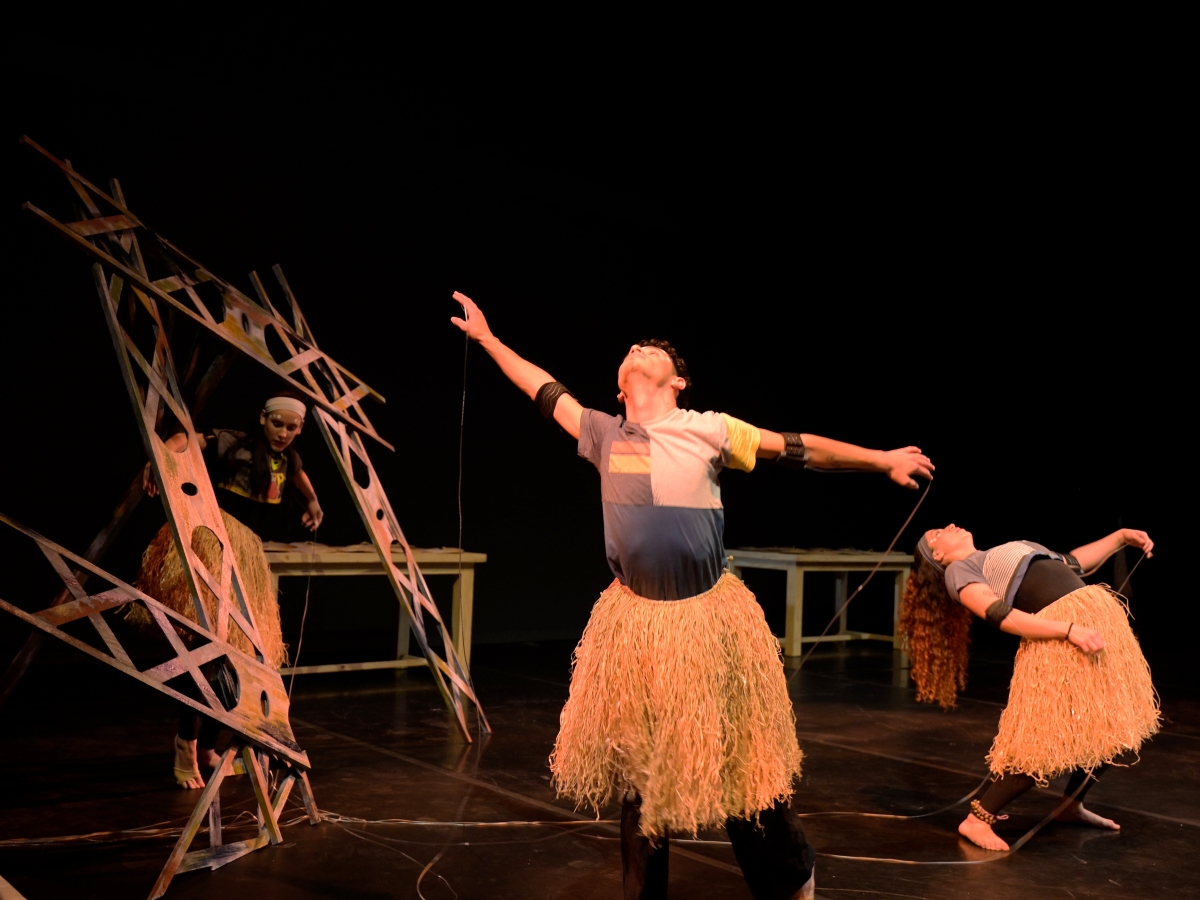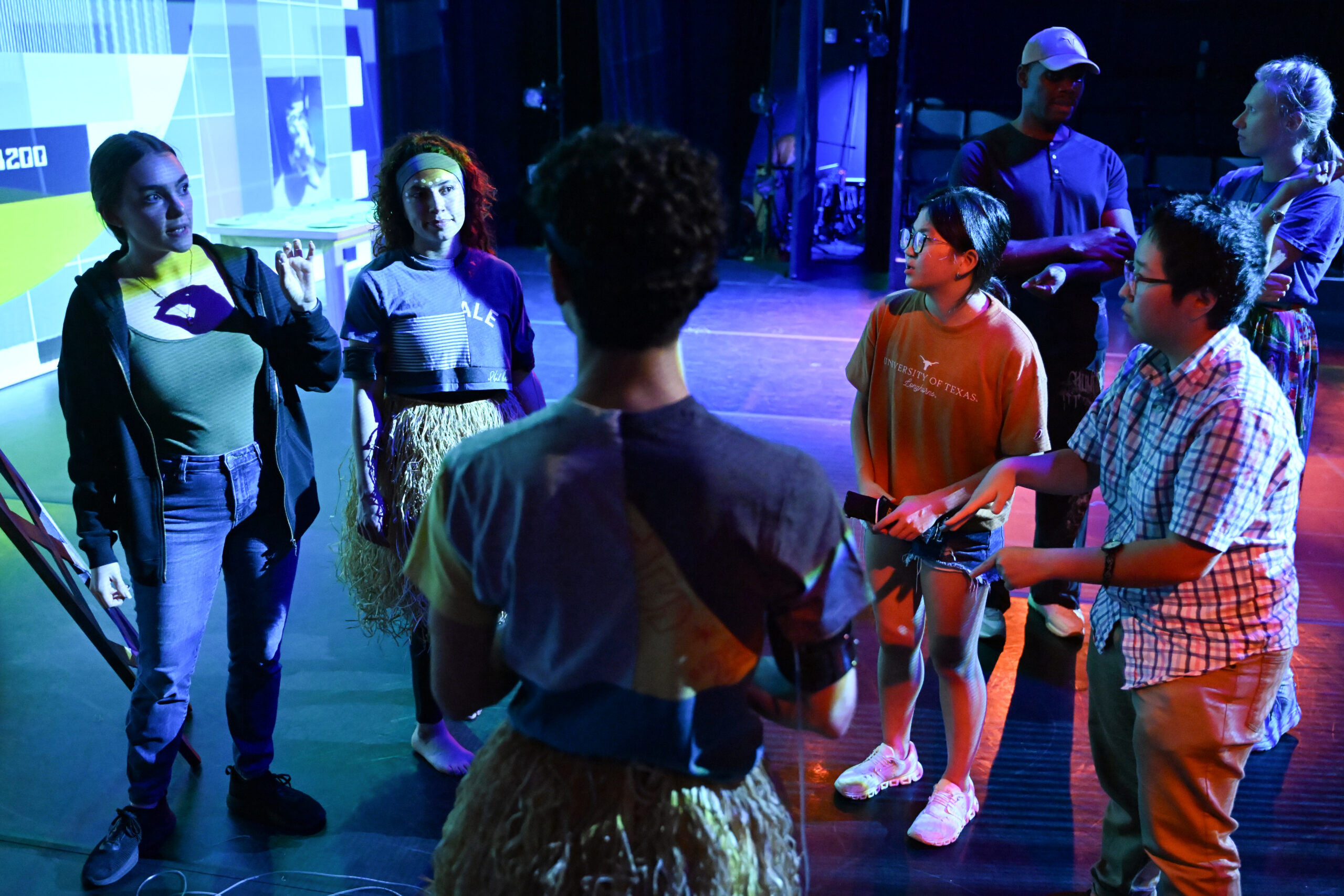Wired for Rhythm
A year-long collaboration yields a unique performance that combines dance with next-generation sensing capabilities.

The first day of school can be awkward, whether you’re an elementary school student or a college professor. But these initial meetings can lead to lifelong friendships and unique partnerships.
That’s exactly what happened for Lillian Chin and Sinclair Emoghene. A chance meeting a year ago at UT’s faculty orientation day between the newly hired professors in the Cockrell School of Engineering and College of Fine Arts has led to an innovative performance that blends African dance with next-generation sensing technologies.

Faculty members Emoghene Sinclair and Lillian Chin and mechanical engineering student Ava Schraeder chat in advance of rehearsals.
“I’ve always been fascinated by using technology to accentuate the story of dancing,” said Emoghene, an assistant professor in the College of Fine Arts’ Department of Theatre and Dance. “We are working with the idea that space does not exist as an empty vacuum but as a living field that dancers continuously shape. And we are creating a visual pathway for these tactile signatures, allowing the audience to witness the emotional atmosphere that dancers usually feel internally.”
Emoghene conceived of and choreographed a performance titled Mé Duniya as part of an ongoing show called Rooted in Motion. This performance, presented by Dance Repertory Theatre, is enhanced by wired sensors strategically placed on the student dancers that gather data and project their movements on a big screen in the form of dynamic light patterns.
Testing out sensors that project and illustrate dancer movements on a big screen.
The sensors are made of 3D printed empty air channels within a structure that can be tailored for specific uses and data needs. When pressed, the air channels compress and the researchers can measure the pressure change using an off-the-shelf pressure transducer.
In the performance, the sensors are attached to the dancers and connected to computers hidden in the backstage area. As the dance unfolded at rehearsals, Chin and her team monitored the sensors on dashboards to ensure everything would go according to plan.
“This has been a great opportunity to test our technology in a very different environment,” said Chin, an assistant professor in the Chandra Family Department of Electrical and Computer Engineering. “Our sensors need to be on point every night, constantly, for these two weeks: simple enough that the dancers and stage crew can put them on night after night, as well as be robust enough to transmit signals no matter what the dancers do.”
Dancers apply the sensors as part of rehearsal for the performance.
It wasn’t just a collaboration among professors; the students teamed up throughout the process as well. Ava Schraeder and Hrishi Sahu in Chin’s lab led the dance project, and they worked with Desne Wharton, a graduate student in the College of Fine Arts and sound/production designer of the show, to visualize the movement on the big screen.
Chin initially designed the sensors for an exoskeleton brace she was working on before coming to UT. She later expanded the work to focus on robotic hands to grip and hold delicate objects. This collaboration has inspired Chin to think about applying her sensors in unconventional places, such as soccer shin guards and shoes.
Mapping the human body has become a big business, especially in sports, and UT is making a mark in that space. This technology has not made its way to dance en masse, Emoghene said, and his mission is to move this art and engineering two-step forward.
“Having used these sensors myself, I felt the same excitement the dancer feels when realizing that their gestures can now literally be seen moving alongside them,” Emoghene said. “For me, being able to activate movement in such an immediate, responsive way has opened a new pathway for research, making me ask, in real time, how movement is transmitted.”

This performance was just the first step of Emoghene’s The Sensorium Project, which aims to explore how touch, force, sound, vibration and projection can create a multi-sensory dance environment that expands access while reimagining what dance can feel like for every kind of body. The next phase will include an immersive installation where audience members, including dancers with different physical abilities, can experience and generate movement feedback through the sensors themselves.
Student dancers in the piece are: Natalia DePaula, Maxima Velasquez, Wynter Winston, Jesus Gutierrez, Natalie Vargas, Giovanni Ledezma, Sydney Gladden, Valentina Reyes Rubio, Bailey Whiteman, Riza Hernandez, Audrey Friloux. Crew members include: Allison Normin Johnson, costume designer; KP Pierce, lighting designer; Desne Wharton, sound/projection designer; Jacob Daniels, music collaboration; Alik Clay, scenic designer; Valeria Nuñez Estrada and Gustavo Hernandez Pinzon, assistant scenic designers.
